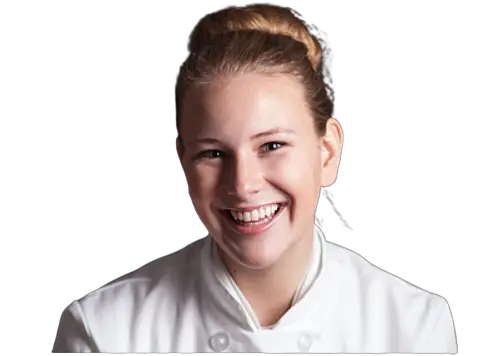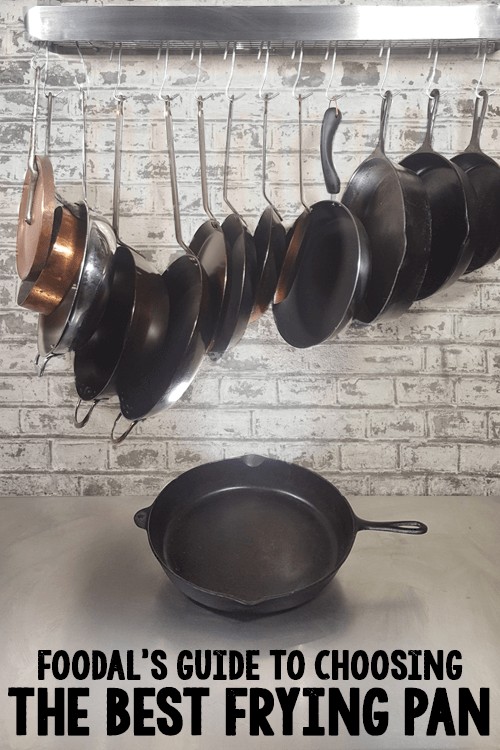Do you love fried foods but hate dealing with small frying pans? If so, then you need a large frying pan. Large frying pans come in handy when cooking for a crowd or when you want to make a big batch of food.
But how big do they get? And what is the best size for your needs? This guide will tell you everything you need to know about large frying pan sizes.
The largest frying pan available on the market is the Lodge Logic 12-inch skillet. It is huge, measuring at 12 inches in diameter and 2 inches deep. The Lodge Logic skillet can hold up to 8 quarts of food, making it ideal for cooking large meals.
If you need an even larger frying pan, consider the Cuisinart Chef’s Classic Stainless 16-inch Round Fry Pan. It is 16 inches in diameter and 3 inches deep, making it perfect for cooking family-sized meals or large batches of food.
When it comes to frying pans, size does matter. A large frying pan is a kitchen essential for anyone who loves to cook. But with so many different sizes available, it can be hard to know which one to choose.
Here’s a quick guide to large frying pan sizes:
12-inch: This is the most common size of large frying pan and it’s perfect for cooking multiple servings at once. It’s also big enough to accommodate a whole chicken or fish fillets.
14-inch: This size is great for larger families or if you entertain often. It can easily fit four hamburger patties or six chicken breasts.
16-inch: The largest size of frying pan available, this behemoth is ideal for feeding a crowd.
You can fit up to eight hamburger patties or ten chicken breasts in this bad boy.
How to choose a frying pan to replace non-stick cookware?
How to measure frying pan size?
If you’re like most people, you probably don’t think too much about frying pan size when you’re cooking. But if you’re trying to cook a specific recipe, it’s important to make sure you have the right size frying pan.
Here’s how to measure your frying pan so you can be sure to get the perfect fit:
1. First, measure the diameter of the base of your frying pan. This is usually easy to do with a ruler or tape measure.
2. Next, measure the depth of your frying pan. This is the distance from the base of the pan to the top edge. Again, a ruler or tape measure will work fine for this.
3. Finally, multiply the diameter by the depth to get the total volume of your frying pan.
This will tell you how many quarts (or liters) it can hold. Now that you know how to measure your fryer size, put that knowledge to use and choose a recipe that’s just right for your kitchen!
14-inch frying pan
When it comes to kitchenware, one size does not always fit all. That’s why finding the right frying pan for your needs is essential. If you frequently cook for large groups or want the option to make larger meals, a 14-inch frying pan is a great choice.
Here are some things to keep in mind when shopping for a 14-inch frying pan:
Size: A 14-inch frying pan has a diameter of approximately 14 inches. This size is ideal for cooking large quantities of food at once.
Material: Frying pans are typically made from either aluminum or stainless steel. Aluminum conducts heat well and is lightweight, making it a good choice for those who don’t want their cookware to be too heavy. Stainless steel is more durable and doesn’t react with acidic foods, but it isn’t as good at conducting heat. Choose the material that best suits your needs.
Coating: Nonstick coatings make cleanup easy and prevent sticking, but they can wear down over time with use. If you opt for a nonstick pan, be sure to choose one with a high-quality coating that will last long term.
What is the largest size frying pan?
If you’re looking for the largest size frying pan, you’ll want to find one that is at least 12 inches in diameter. This size will allow you to cook large meals without having to worry about the food not fitting in the pan.
Additionally, a larger frying pan will also give you more surface area to work with, which can be helpful when cooking multiple items at once.
12-inch frying pan
When it comes to cookware, one size does not fit all. That’s why having a variety of frying pans in different sizes is essential for any kitchen. A 12-inch frying pan is a great option for cooking larger meals or for when you need to feed a crowd.
Here are some things to keep in mind when using a 12-inch frying pan:
1. Choose the right material: When it comes to fry pans, there are many different materials to choose from including aluminum, stainless steel, and non-stick coatings. Each material has its own advantages and disadvantages so it’s important to select the one that best suits your needs.
For example, aluminum pans conduct heat well but can be difficult to clean. Stainless steel pans are durable and easy to clean but don’t conduct heat as evenly as aluminum. Non-stick coatings make cleanup a breeze but can be less durable than other options.
2. Preheat before cooking: It’s important to preheat your pan before adding any food to it. This will help ensure that your food cooks evenly and prevents sticking. Simply place your empty pan on the stove over medium heat and let it warm up for a minute or two before adding oil or butter (if desired) and your food items.
3. Use the right amount of oil: Many people make the mistake of using too much oil when cooking in a fry pan which can lead to greasy, unhealthy food. To avoid this, add just enough oil to coat the bottom of the pan – about 1 tablespoon should do the trick unless you’re cooking large quantities of food then you may need 2-3 tablespoons.
Tefal frying pan sizes
There is a lot to consider when purchasing a Tefal frying pan. Size is an important factor to think about because it determines how much food you can cook at one time.
Here is a helpful guide to the different sizes available and what they are best used for:
1) 8” frying pan: This size is great for cooking smaller meals for one or two people. It’s also perfect for side dishes and making smaller quantities of food.
2) 10” frying pan: This size is ideal for cooking larger meals for three or four people. You can also use it to make multiple servings of a dish.
3) 12” frying pan: This size is perfect for cooking family-sized meals or entertaining guests. You can easily cook multiple dishes in this fryer, making it ideal for large gatherings.
10 inch vs 12 inch pan!
When it comes to baking pans, size does matter. The most common sizes for round cake pans are 8 inches, 9 inches, and 10 inches, while the most common size for square cake pans is 8×8 inches. But what is the difference between a 10 inch pan and a 12 inch pan?
For starters, a 10 inch pan will hold about 2 quarts of batter while a 12 inch pan will hold 3 quarts. That means you can make a taller or larger cake in a 12 inch pan than you could in a 10 inch pan. In terms of circumference, a 10 inch pan has about 31 inches of circumference while a 12 inch pan has about 37 inches.
Another key difference is that 10 inch pans have straight sides while 12 inch pans usually have sloped sides. This may not seem like a big deal but it can actually make quite a difference when it comes to baking cakes. Cakes baked in straight sided pans tend to be more evenly cooked and have straighter edges.
Cakes baked in sloped sided pans often have irregular edges and can be overcooked on the sides closest to the wall of the pan.
So which size should you choose? It really depends on what you’re looking to bake.
If you want to make a tall cake or one with lots of layers, go with a 12 inch pan. If you want something smaller or want straighter edges on your cake, go with a 10 inch pan.

Credit: cookforfolks.com
What size is considered a large frying pan?
When it comes to frying pans, size definitely matters. A large frying pan is generally considered to be any pan that has a diameter of 12 inches or more. This extra surface area can come in handy when you’re cooking for a crowd, or simply want to make sure your food has plenty of room to breathe while it’s cooking.
Of course, there are always-exceptions to the rule. If you’re looking for a large frying pan that can accommodate especially big batches of food, you may want to go with a 14-inch or 16-inch option instead.
And if you’re tight on kitchen space, don’t worry – there are plenty of compact 10-inch and 11-inch models out there that will still get the job done without taking up too much real estate on your stovetop.
What sizes do frying pans come in?
Frying pans come in a variety of sizes, from small 8-inch pans to large 12-inch pans. The most common size is 10-inches. When choosing a frying pan, think about the type of food you’ll be cooking and how many-people you’ll be cooking for.
If you’re cooking for one or two people, a smaller pan will do. If you’re cooking for a crowd, or if you like to cook large meals, then a larger pan is a better choice.
How is a 10 inch frying pan measured?
A 10 inch frying pan is measured across the top from one side to the other. The inside bottom of the pan is where the measurement is taken. The depth of the pan is measured from the inside bottom up to the inside rim.
Conclusion
Frying pans come in a variety of sizes, from small 8-inch pans to large 16-inch pans. The size of the pan you need depends on how many people you’re cooking for and what you’re cooking. Smaller pans are great for individual meals or side dishes, while larger pans can accommodate multiple servings or large cuts of meat.
When choosing a frying pan, it’s important to consider the material it’s made from. Stainless steel, aluminum, and nonstick surfaces are all popular choices. Each has its own advantages and disadvantages, so be sure to choose the right one for your needs.

I Am Alexis Brown. A food blogger and recipe developer who has been writing about healthy, delicious recipes since 2015. My blog, fooderzone.com, features both original content as well as adaptations of popular dishes from other sources.
I am love to share my knowledge with others by writing instructional articles on topics such as cooking for people with diabetes, meal planning for busy women, low-glycemic eating options for people on the go, and more. And also offers a range of free resources including printable recipes and shopping lists.


Pingback: How Much Fruit Salad You’Ll Need For A Large Group -